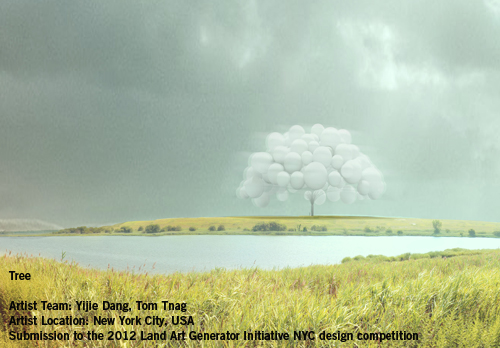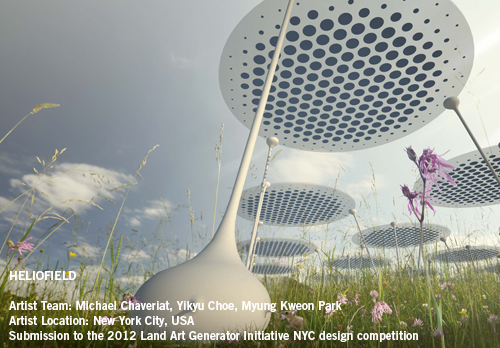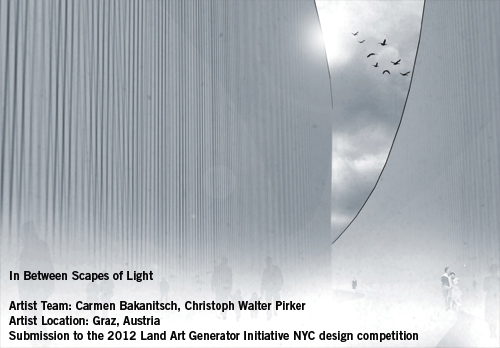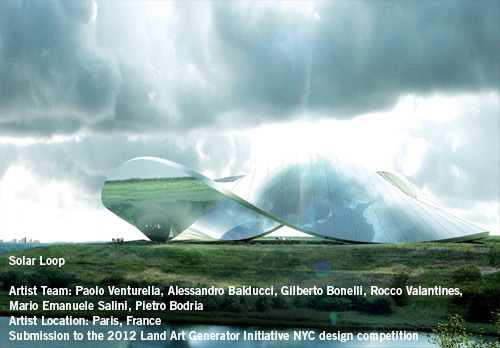
Thank you to everyone who participated in the LAGI NYC 2012 competition to design public artwork that generates utility-scale clean energy for Freshkills Park (the former Freshkills Landfill). On July 1 we received 250 submissions from 39 countries. The quality of the submissions to this year’s competition has been truly inspiring.
Over the upcoming months we will be writing articles here at BLAGI about selected submissions. In the meantime, we have decided to make public the online portfolio that showcases nearly all of the qualified entries. You can now see this site by going to the LAGI portfolio.
In July we held a shortlisting evening in which a team of professionals got the submissions down to the top 25 submissions. Thank you to Decker Yeadon, LLC for hosting this evening in their lovely space at Metropolitan Exchange in Brooklyn. And thank you to everyone who provided his or her thoughtful insight!
The official jury team deliberated during the month of August to determine the winning design solutions. We cannot thank them enough for their dedicated time and expertise.
As always, thank you to our supporters:
The National Endowment of the Arts, Horne Family Foundation, Zayed University, and many individuals
and our partners: New York City Parks & Recreation, the Coalition for Arts & Humanities Staten Island, Institute for Urban Design, and Zayed University.
On October 25 we will be holding a public event in New York City where we will announce the winners of the 2012 competition.
Following are just a few examples of the many amazing submissions. Please note that we’ve picked these as a random sampling before the jury process started, so you won’t get any hints here as to who the winners are!

TREE
Artist Team: Yijie Dang, Tom Tnag
Artist Location: New York City, USA
Energy Technology:
Kinetic generators such as the M2E Power Kinetic Battery, piezoelectric generators
Annual Capacity:
1,000 megawatt-hours
“Trees are a symbol of renewal and the interconnectedness of all things. At Fresh Kills Park, nature is literally being restored by manmade intervention. A large tree could provide shading for the visitors and serve as a symbol for the park. However, the landfill cap at Fresh Kills contains only enough soil for grasslands and is not deep enough to support the large roots of a wide canopy tree. However, if that tree were artificial, it could generate electricity, provide lighting, provide shading, and not require the deep roots that a real tree would need. Our solution: a 90ft tall tree made of recycled industrial balloons and PVC pipes. This artificial tree simultaneously alludes to the manmade past of the site and the role of the park as renewal of the natural while also providing shading for the visitors and harvesting energy through the swaying and bending of the branches.
During the day, the sun heats up the balloons and the canopy size increases, providing more shading and bending the branches to generating energy. As the balloons sway in the wind, kinetic generators such as the M2E Power Kinetic Battery at the base of each balloon work like an automatic watch and produce electricity through the swaying motion. Along the branches, spaced every 3 ft, are more kinetic generators, piezoelectric generators, and LEDs. This combination creates electricity from the bending of the translucent PVCs with piezoelectric ceramic plates, captures energy from the movement with the kinetic generators, and lights up to indicate electricity harvesting.
At night, the balloons are slightly reduced in size and produce a luminous glow while generating energy. The tree should be placed on the north hill where it is visible and accessible from West-Shore Expressway. The tree is many things: symbolic, literal, and sculptural. But it is also practical: providing shading, generating electricity, educating visitors about the site’s man-made past. It is all those things simultaneously. It represents renewal and the interconnectedness of all things.”

Scene-Sensor // Crossing Social and Ecological Flows
Artist Team: James Murray, Shota Vashakmadze
Artist Location: Atlanta, USA
Energy Technology:
photovoltaic thin film (amorphous silicon) and piezoelectric generators
Annual Capacity:
5,500 megawatt-hours
“Key interactions of human and ecological energies, above and below the surface of Freshkills, drive complex environmental flows, allowing us to question how to sense, channel, and harness their energies in a productive tension, revealing their interconnected fluctuations in beneficial ways.
Scene-Sensor situates itself at the intersection of flows joining and separating opposing landforms: as a channel screen, harnessing the flows of wind through the tidal artery, and as vantage points, staging crosswise pedestrian flows through the park, the two acting in combination as a mirror-window, reflecting and revealing the scene of Freshkills’ fluctuating landscape back to itself.
The undulating landforms, both above and below the surface, are products of duelling forces: natural and artificial composition. An invisible trace of material history is pinned between its identities of wilderness, marsh, landfill, and public space. But these forces, the flows of human and ecological energies that have transformed the site, are only understood in solitude, outside the reciprocating senses that have defined their existence. The social and ecological are treated as being mutually exclusive, as opposites whose interaction can only further fragment the confluence of the landscape. Our proposal constructs a union of these seemingly disparate flows, setting the stage for one another through a sensor of visible and invisible forces: the Scene-Sensor.”

HELIOFIELD
Artist Team: Michael Chaveriat, Yikyu Choe, Myung Kweon Park
Artist Location: New York City, USA
Energy Technology:
photovoltaic thin film (amorphous silicon)
Annual Capacity:
15,000 megawatt-hours
“Heliofield is an energy-generating network of solar modules that rise out of the prairie grasses of Fresh Kills Park. The topography and tabula rasa quality of the former landfill site make it ideally suited to collect the locally abundant and renewable solar energy that shines on Staten Island. Heliofield aims to establish dynamic relationships between technology, landscape, and the site’s occupants, whether they are people, plants or animals.
Utilizing state-of-the-art technologies in its solar modules, Heliofield increases efficiency while minimizing production costs. Nanosolar is a company on the cutting edge of solar PV semiconductor research manufacturing. The proprietary approach to printing CIGS (Copper, Indium, Gallium, Selenium) and nanoparticle inks minimizes our use of expensive, high vacuum manufacturing equipment. Nanosolar grows a thin film semiconductor using a printing and annealing process that is much faster than conventional methods.
Recent advances in nanoscience are utilized to create high quality, highly uniform layers of nanoparticles dispersed through proprietary CIGS ink. This allows for the use of equipment from the industrial printing industries to produce solar-electric foil at high speeds and great quantities.
The unique conditions of the site call for an inventive approach to the infrastructure needs for a such a large-scale intervention. What appears to be a rugged and wild landscape is, in reality, highly managed and delicate. As to not disturb the landfill cap, Heliofield uses massive feet as andchors and thin, stilt-like legs to elevate the PV panels above the prairie grasses while delivering electricity throughout the system. There are no footings, foundations, electrical cable infrastructure to be concealed/buried. Electricity collection and delivery systems are contained within each unit. This system of components affords great flexibility and scalability.”

In Between Scapes of Light
Artist Team: Carmen Bakanitsch, Christoph Walter Pirker
Artist Location: Graz, Austria
Energy Technology:
Three-dimensional Dye-Sensitized Solar Cells
Annual Capacity:
4,500 megawatt-hours
“In this process we are developing the element of the line. A line it is meant to be that draws, creates space. A line that winds, bends, runs and stands still. A line that disappears, hides, surprises, thuds, beats, divides, connects, caresses. A line that is tender, brute, defiant, brave, square, light as a feather, clear, glittering, colourless, glowing. We want to create a line that is atmospherically as dense as the blackest black, dense as the brightest purple chrome. A line that allows man to hear the wind blow. Aiming to achieve this goal we cannot regard a line as just a two-dimensional object but as an element that is seeking space.
Based on recent research studies the volume of the line is formed by millions of extremely thin solar threads, optical-fiber-based 3D Dye-Sensitized Solar Cells. The solar threads arrayed in a distance of 10 centimetres from each other form the proportions of our line: a depth of 5 metres and a height of 10 metres.
Then we will further increase this atmospheric density by employing additional elements of line. We place them in front and behind each other, make them interfere and form relations with each other, thus creating not only spaces within the volume itself, but spaces, spaces in-between, spaces as a result of adding more such lines. Thus the lines are not set into the landscape as mere objects but in powerful gestures that seeking space refer to themselves, to man, to the wide open of the location, grasping it and responding to it. The solar threads, the essential part of the Atmosphere, are fixed on the Structure which appears from the outside as the narrow horizontal finishing upper part. This plate also serves to support the system as a static reinforcement and a means to transport the energy generated by the solar threads. The solar threads do not touch the ground but keep a distance of one metre to it as if waiting for an answer.”

Solar Loop
Artist Team: Paolo Venturella, Alessandro Balducci, Gilberto Bonelli, Rocco Valantines, Mario Emanuele Salini, Pietro Bodria
Artist Location: Paris, France
Energy Technology:
Thin Film Photovoltaic
Annual Capacity:
10,000 megawatt-hours
“The aim of the «Solar Loop» is to expose more surface as possible to the solar rays during the day. The shape comes directly from the solar diagrams, and deals easily with the sun following it with the best angle, almost like a frozen artificial sunflower. The shape is designed to be the most efficient solution, calculating the angle of the sun’s rays as the average of the angles of the winter and the summer solstice.
The aesthetic of the sculpture is the result of this dialogue that becomes synthesis between the solar power and freshkills park.
Thinking in small it could be a shader, thinking in big could be an arena to organize medium/big events inside such as concerts, sports events, speeches: ready to be the new point of reference for the park’s visitors.
The «Solar Loop» is composed by two different surfaces that twist one into the other. The first one is the photovoltaic surface always exposed to the sun with the most performative angle, the second is the mirrored surface that reflects all the surrounding to multiply the spectacularity of the landscape as a single either multiple landmark.
The Fresh kills’s East Park is the only most sunny part of the park all the year long, and the easiest accessed park visually connected with the Manhattan Skyline.
A solar catalyst, a crowd and cultural catalyst it will be the park’s nest.”
